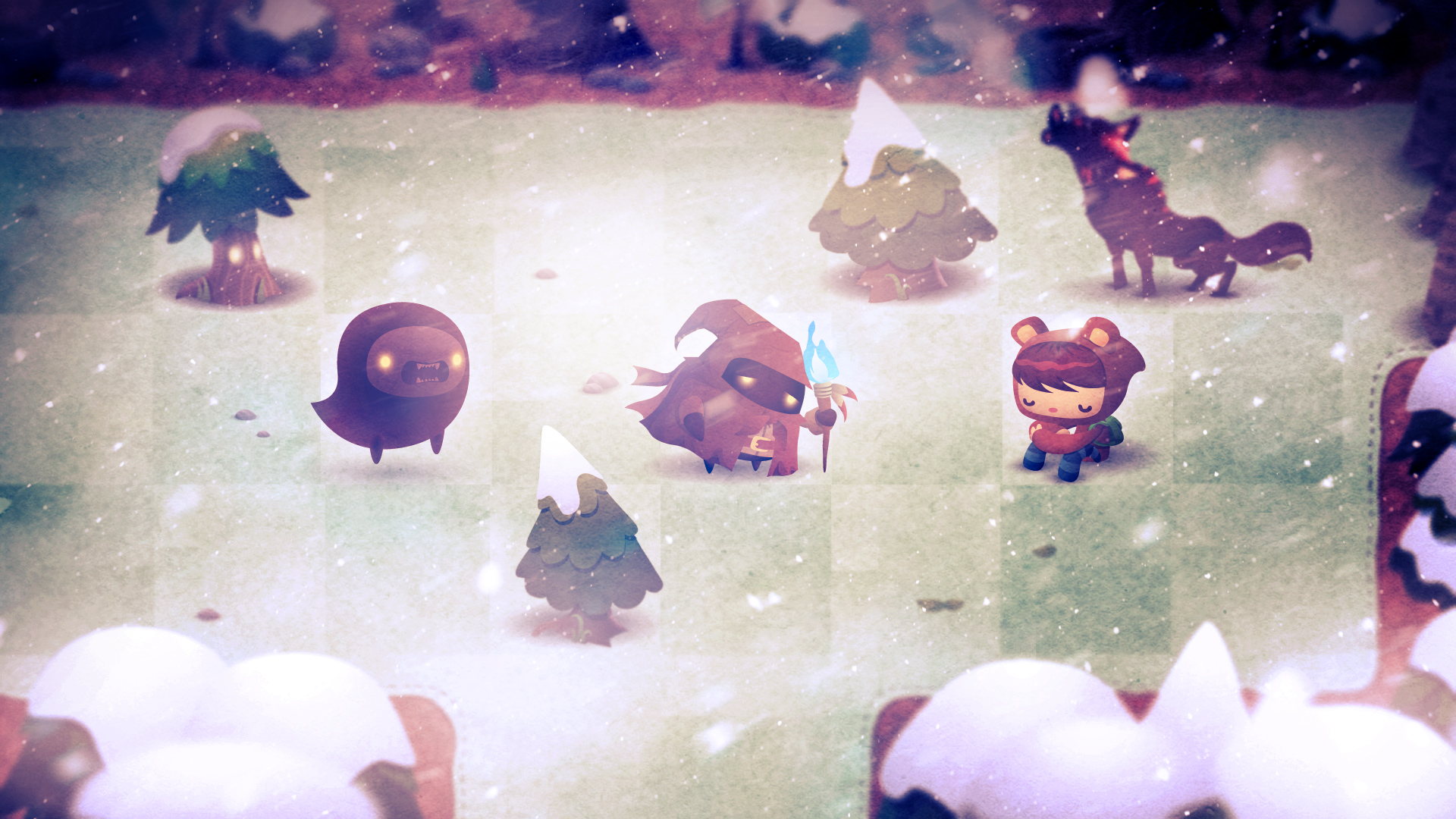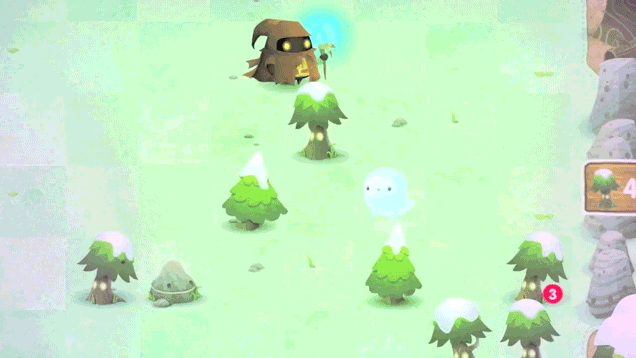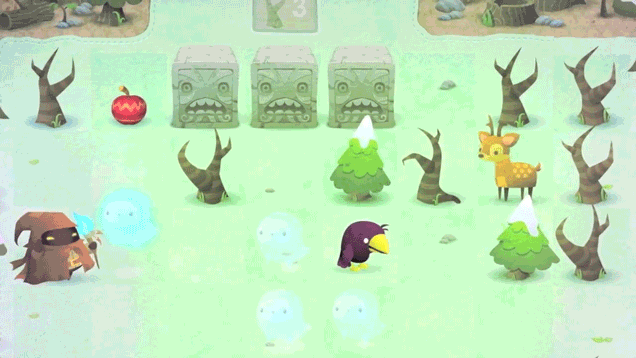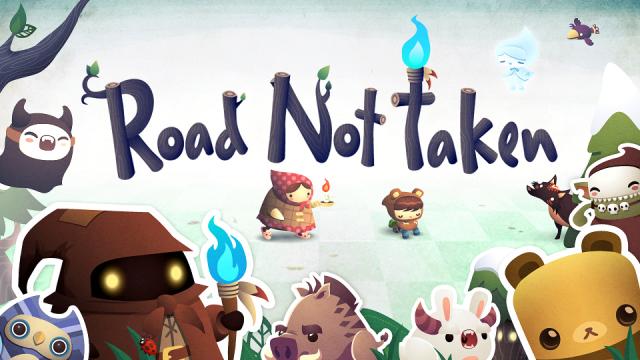When I sat down at a park bench in the Yerba Buena gardens by the Game Developers Conference last week to play a build of Road Not Taken — a game named after the Robert Frost poem — my initial thought was that it seemed too adorable to say anything particularly deep. Like say, commenting on the inability to lead a perfect life. Or regret.
I mean, just look at the initial picture on this post, a promotional image that gives you a good sense of what the game looks like. The protagonist looks like a chibified version of the more elegant protagonist of Journey. Don’t let that aesthetic fool you, though — just because we’ve had years of conditioning that say only dark, gritty and brown convey deep, mature themes in games doesn’t mean its actually true.
“I wanted to do something a little more personal,” Daniel Cook, Chief Creative Officer at Spry Fox — the developer behind the game — told me. “The theme of it is, you know how you go through life and there’s sort of a story that you’re told? You go to school, you get a job, you fall in love, you get married, you have kids…and then you get to a certain point, maybe it’s in your twenties or wherever it might be…and you realise, woah, I’m totally not on that [roadmap]. This is a game along those lines.”
To understand how the game tackles these ideas, you need to understand how it works.

The demo I played starts off with the player delving deep into an enchanted forest in search of lost children. Your goal is to reunite the kids with their family. Naturally, the maze-like forest is full of wild creatures though, and it’s also randomly generated — so you can’t memorize how to go through it. Thankfully, you have something to help you along the way. Your initial ability is simple: you can pick objects up and carry them around, as well as throw them. You can carry or throw objects like trees and boulders lying around the map as well as people, amusingly enough (this is how you save the children: by throwing them).
You can’t just waltz through the forest, though. In the few puzzles that I saw, each new section of the forest was gated by signs that demanded a certain number of specific objects next to each other. If a sign standing in the way between me and the next portion of the map had a “four trees” sign, for example, I couldn’t progress any further unless I got four of the trees on the map next to each other using my object levitation ability. Like so:

The goals are clear and simple, but there are a few problems that stand in your way. Getting an object next to another one of its kind can require some clever manoeuvring — you can only throw an item in the direction you’re facing when you pick the item up. Beyond that, other objects might stand in the way of the thing you actually need — which means you’ve got to interact with stuff that has effects/abilities that are a complete mystery to you (this is part of why the game is classified as a roguelike).
Maybe you need to get a few red boulders next to each other, except picking up a red boulder and tossing it down the map will turn it into a blue boulder. Effects like these make puzzles that seem simple way trickier, especially when you don’t initially know this is going to happen (the boulder example happened to me, and it took me a few minutes to realise what exactly was turning the boulders I needed into useless boulders of a different colour). Or maybe every time you move around, a strange fairy-like creature also moves about — and you have no idea what will happen if your character actually touches the fairy. Or maybe you come across a pooping goat which you have no idea what to do with. Or maybe you accidentally combine two items that you meant to use — the game has a crafting system. These are just a few of examples of things that make the puzzle game at once frustrating, enticing and fun.

To make matters more complicated, your character has a set amount of stamina that is drained when you pick stuff up — and if you run out of stamina, that’s it. Game over. You lose some progress and items, just like you might in recent roguelikes such as Spelunky and Rogue Legacy. Actually, if enough in-game time passes, you die anyway. Each foray into the forest takes one year out of your life, which makes the child-saving seem that much more high-stakes. You’ve got to make the most of the time you’ve got, and even when you try your best, it may not be enough. You won’t be able to save the kids all the time — heck, you won’t be able to save yourself all the time.
The build I saw didn’t have everything in it yet, I saw the early stages of a home town of sorts, where players can talk and interact with townfolk. Though I didn’t see specific ways in which this is the case, I was told that people who live in the town are affected by your actions. Cook told me that you’d even be able to romance characters, as well as do standard roguelike things, like upgrade yourself in some ways and have a home base. While I didn’t play it for very long, it was clear to me that Road Not Taken had a surprising amount of depth to it.
Despite its cuteness, Road Not Taken seems like an interesting meditation on life. It’s built on difficulty, trial and error, as well as the pursuit of perfection. You try and try again, in the hopes of getting it right this time, in this playthrough. Maybe it will work. Maybe it won’t. The game also requires you to be ever-aware of your own mortality, and inevitable death. You can have a roadmap for life, set milestones, have a gameplan but stuff just doesn’t turn out the way you think it will — and while in real life it means we have to readjust and do what we can with what we’ve got, games like Road Not Taken allow us to have more than one shot. Spry Fox says it takes multiple playthroughs to have the themes fully unfold for the player, but I’m already liking the sorts of things it makes me think about.
The game releases sometime later this year on the PS4, Vita and Steam.

Comments
One response to “Here’s A Game You Can’t Judge By Its Graphics”
Looks very very similar to the Lost Winds art style!
The art style in this looks a bit like Animal Crossing combined with Scribblenauts! Pretty cool style!